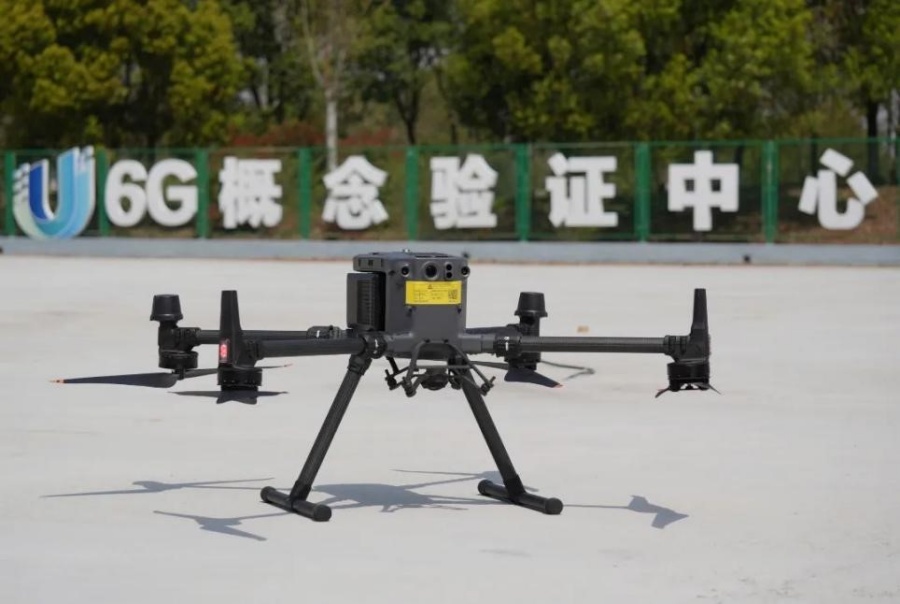China's 6G vision forges an era of universal intelligence

During the 2024 Nanjing Marathon, Purple Mountain Laboratories deploys 6G-enabled security drones for real-time video monitoring. [Photo from the WeChat official account of Angmobile]
As 2025 dawns, the global telecommunications industry marks a pivotal moment: the commencement of the " 6G standardization era." International standards bodies are expected to crystallize by 2029, with initial commercial trials slated for deployment around 2030.
While 5G already delivers impressive capabilities: ultra-high speeds, minimal latency, and massive connectivity, 6G promises a quantum leap. It targets transmission rates exceeding 100 Gbps while slashing latency below one millisecond, crucial for real-time applications like smart-factory robotics and remote equipment operation.
In terms of connectivity, 6G will integrate exponentially more devices, particularly sophisticated Internet of Things (IoT) systems, intelligent terminals, and biomedical sensors, laying the groundwork for a truly intelligent, interconnected world.
6G transcends mere speed enhancement. Its revolutionary potential stems from three integrated dimensions. First is sensing-communication integration, where communication signals not only transmit data but perceive physical environments. Second is terrestrial and non-terrestrial synthesis, with unified networks spanning ground, air, underground, and underwater for ubiquitous coverage. Third is communication-intelligence convergence, with computational intelligence embedded within network architecture. These advances will transform 6G from a communication medium into a comprehensive next-generation mobile information network.

Photo shows a 6G concept verification test flight site, jointly established by a national university technology transfer center for information and communications in east China's Jiangsu province and Purple Mountain Laboratories. [Photo from the media center of Jiangning district of Nanjing, east China's Jiangsu province]
As of June 2024, China retains its leading position worldwide of 6G-related patent applications. Regarding fundamental research, the longstanding "impossible triangle" in wireless communications - balancing latency, reliability, and throughput - has historically constrained progress. Now, researchers at China's Purple Mountain Laboratories have pioneered spacetime two-dimensional channel coding, a breakthrough enabling ultra-reliable, near-instantaneous 6G transmission.
Engineering milestones further cement this momentum. Last July, Academician Zhang Ping from the Chinese Academy of Engineering unveiled the world's first field test network for 6G communication and intelligent integration.
China's telecommunication operator China Mobile, in collaboration with the ZGC Institute of Ubiquitous-X Innovation and Applications, developed a cloud-native 6G prototype system, achieving single-user rates surpassing 8 Gbps and validating more than 10 novel 6G technologies via a ten-site network. In February 2023, China also launched the world's first satellite to test 6G architecture in space.
The concurrent rise of AI, robotics, and low-altitude economy technologies, coupled with the intelligent transformation of manufacturing, propels 6G advancement. Empowered by unprecedented advancements in sensing, computing, big data, and AI integration, 6G is expected to unlock transformative applications.
Consider low-altitude drones: future 6G networks could imbue them with real-time environmental perception and distributed computing capabilities, optimizing design and extending flight time. Similarly, embodied AI robots could offload computation-intensive tasks to nearby 6G base stations, yielding lighter, more durable, and cost-effective units, paving the way for mass adoption across industries. This signals 6G's fundamental distinction: not merely an incremental upgrade from 5G, but a core technological pillar poised to reshape entire industrial ecosystems.
In transportation, 6G could drive the construction of fully connected transportation systems and smart cities, seamlessly connecting surrounding vehicles, infrastructure, and pedestrians. Such integrated systems would enable truly intelligent traffic management and make fully autonomous driving to a reality. Pilot projects based on these principles are already being deployed in several Chinese cities.
Globally, however, perceptions of 6G's trajectory remain fragmented, reflecting divergent technological infrastructures and developmental priorities. Technical discussions must evolve beyond simplistic metrics like peak speeds and latency reductions because 6G's true potential lies in embracing cross-disciplinary innovation. Strategically, it cannot be viewed through a single-industry lens, but as a foundational enabler for digital and intelligent transformation across all sectors.
To that end, global industry stakeholders must strengthen collaboration and strive toward early technical consensus. Such alignment will be vital for establishing unified global 6G standards and ecosystems.
Liu Guangyi is the chief expert of China Mobile and chief scientist of the ZGC Institute of Ubiquitous-X Innovation and Applications. The article is based on an interview with Liu by People's Daily journalist Yu Sinan.
























